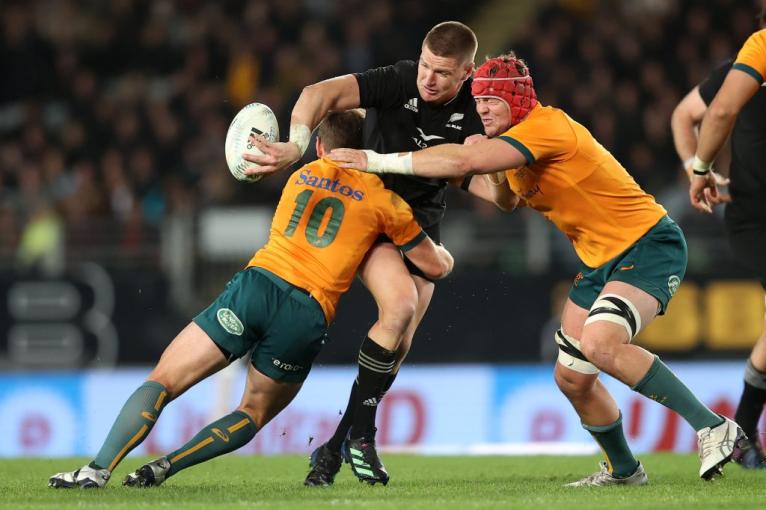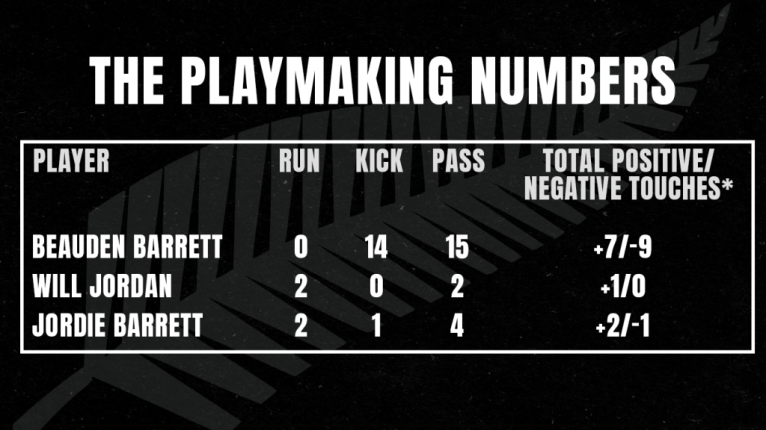The date was 24 September 2022, and the man of the hour was Jordie Barrett. New Zealand had just beaten Australia at fortress Eden Park by a thumping margin, 40-14, and Barrett had been the star turn. It was first time Ian Foster had selected him at the pivotal inside centre spot and the youngest of the Barrett brothers duly showed him what he had been missing.
His stats were a revelation and they still gleam in the silence of twilight, highlighted on my database – 17 carries for 81 metres [over half of which were yards-after-contact] seven tackle busts, five offloads, three kicks and one line-break assist.
That night in Auckland, Barrett made the lives of Pete Samu and Bernard Foley an utter misery. The attacking 12 often homes in on the seam between the defensive number seven and 10 in the modern game and on that fateful evening, Samu and Foley completed only 13 of 23 tackle attempts between them.

It really was the start of a new world, a garden of Eden for Barrett. He was in the process of being anointed as the spiritual successor to one of the all-time greats: the dreadlocked one, Ma’a Nonu. Like Barrett, Nonu enjoyed a winding and convoluted journey to the 12 jersey, and his playing career was probably saved by the desire of Kiwi coaching’s ‘holy trinity’ – Sir Graham Henry, Sir Steve Hansen and Sir Wayne Smith – to unearth a true triple threat who could run, pass and kick outside Dan Carter.
Ted, Shag and the Professor were always willing to lift the cloth and look under the table for players who had the potential to become all of these things at the highest level, even if they were currently occupying another position for club or province.
Nonu was not selected to the ill-fated 2007 World Cup squad and that worked in his favour. He was untainted by either the debacle of the quarter-final loss to France in Cardiff or the traumatic, self-flagellating review back home afterwards.
Despite having played all his rugby at outside centre or wing, the three wise men picked out the dim outline of an outstanding inside centre lying dormant within Nonu’s hulking frame. He already had the size and power to interest defenders in the straight-ahead run. It was left to ‘Smithy’ to develop his long passing, his kicking game and ability to function as a second set of eyes for Carter.
The project succeeded so well that Carter, Nonu and his fellow Wellingtonian at centre Conrad ‘the Snake’ Smith, ended up sharing 309 caps between them for the All Blacks between 2003 and 2015. Say their names now, and it is more like a hushed prayer. You find yourself talking in reverential tones about three of the most rounded hosts of the number 10, 12 and 13 jerseys in the history of the professional game.
Wind the clock forward to 2024, and the efficacy of the Kiwi playmaking triple threat is not quite at the same level of operations. In fact, it is nowhere near where it used to be a decade ago. The trio picked for last weekend’s game at Twickenham were Beauden Barrett at 10, Jordie at 12 with Crusader Will Jordan sitting behind both at 15.
In the first hour, when all three were playing in their starting positions together, the stats for their appearances as a first receiver, orchestrating the play on attack read as follows.

Of the three, it appeared only Beauden Barrett was trusted to run the cutter and navigate his team up and down the field. He had the lion’s share of touches [73%] from first receiver in those 60 minutes, with Jordan and Jordie reduced largely to bit-part players. But the man who enjoyed the most service from his forwards can no longer be seen as a true ‘triple threat’ at this stage of his career. Barrett Snr did not take on the defence once from first receiver in the first hour of the game.
His brother’s running stats [11 carries for 85 metres] look impressive in isolation, comparable to his numbers on that historic night in Auckland, but a deeper dive reveals more contrasts than similarities: at Eden Park he had seven tackle busts and five offloads, but those numbers dwindled to one and zero respectively at Twickenham.
Despite having the best run/pass/kick balance of the three potential playmakers, Jordie was handed the controls all too rarely. He only kicked twice, despite having the biggest and longest boot of anyone on the field. When given the chance, he showed he could be big and accurate off the right foot.
The steepling height of the kick gives Mark Tele’a plenty time to enter the landing zone and jockey for pole position with Marcus Smith. Combine that with Jordie’s threat to outkick the defensive backfield straight down the pitch and it presents a problem without any obvious solution for the opponent.
A true triple threat is able to keep his options open until the very last moment – even from exit situations deep in his own end, even in the teeth of the defence, as the jaws are about to close around him.
At present, New Zealand do not give the ball nearly enough to the player best able to use it from first receiver. The All Blacks stand to benefit from promoting the youngest of the Barrett clan to the forefront of the play far more often.

This is just the type of scenario where you want your premier triple threat player taking the tide of affairs at its flood. Barrett can run straight into the seam between England hooker Jamie George and number six Chandler Cunningham-South, he can pass out the back to Jordan; or he can launch a short, flat kick-pass across to Tele’a. In the event the play is broken up by an excellent read from the England flanker, but there is ample potential for an improved outcome.
The need for a change is sharpened by the uncertainty surrounding the playmaking partnership between Beauden Barrett and Jordan. There was one outstanding moment when the pair read each other’s intentions perfectly to exploit a gap in the defence at ruck-side.
But there were rather more occasions where the understanding between the twin playmakers at 10 and 15 broke down.
In both instances one of New Zealand’s two main power carriers in the backline is used up on first phase – Caleb Clarke in the first clip and Jordie Barrett in the second – and Beauden Barrett pulls the defence on towards the receiver by turning in the direction of the pass on the next phase. The domino effect is to expose Jordan’s loose decision-making on the deck after taking contact. In both cases the outcome is a potentially fatal turnover of possession.

The overall impression is the pieces of the playmaking jigsaw do not quite fit together as harmoniously as they might. With Beauden Barrett and Jordan absorbed on the same phase of attack in the first clip, there seems to be no thought of using Jordie Barrett to fill in at first receiver on the next play, and the ball floats harmlessly past a line of forwards, to nobody in particular.
Jordan is shoe-horned into provider in the second example when he is far better cast as a striker or finisher, with another breakdown in connection between forwards and backs occurring on the very next phase of possession.
Jordie Barrett’s outstanding first match for the All Blacks after his momentous switch from 15 to 12 two years ago now seems like a wistful dream. Everything went right for the youngest Barrett brother in his Auckland fantasy, as it did for most of the season that followed playing outside Richie Mo’unga.
The task of completing his transformation into a triple threat as deadly as the dreadlocked one still remains. It is a work in progress – one which should have progressed much further down the tracks by now.
The problem is one of perception: in the current regime, Barrett is perceived as someone who supplies the go-forward, the midfield grunt, not as a player who can create opportunities for others. That limits his ability to become the best version of himself and touch his highest performance ceiling. As Jordan is more comfortable as a finisher rather than as a provider, it means there is a gaping hole waiting to be filled alongside the wearer of the 10 jersey.
Take a look at the roles fulfilled by Beauden Barrett [or Damian McKenzie], Jordie Barrett, Rieko Ioane and Jordan. Now remember the harmony of purpose among Carter, Nonu and the two Smiths, Conrad and Ben. Look at each unit within the context of ‘triple threat’. There is no comparison.


Great article - certainly highlights why ABs backs are struggling to consistently show a real attack threat - never forget JB's booming kick in the dying minutes of the 2022 Ellis Park game deep into Bok territory. Now all DMAC and BB do is kick directly down throats of defending three.
First step is play BB on bench, second find a 13 that distributes so we only have Jordie so far
Er and the 2nd half stats? Or are you only commenting on half a game because we both know that by the end of the game AB's had played pretty much twice as much rugby as England
Great analysis Nick. I'd forgotten how effective Jordie was when he started in the 12 jersey, that certainly feels a long time ago.
I'm curious though, ignoring his mixed performances from the pine, Lienert-Brown has looked a far better distributor at 12 than JB. He's been able to find half gaps, hold his pass perfectly and free up others outside him. Jordie for me always looks for contact.
Does that mean they're playing to different instructions? Or perhaps there's an issue with Jordie himself?
Great analysis Nick. A number of people have discussed the way Jordie has been used by Razor in the comments of many articles.
Many people are calling for him to be dropped etc... but as you have pointed out he is just not being used in the way he was most effective. He was such a big unlock for the ABs attack in 12 months leading up to the World Cup but Robertson has taken things in a different direction but left the same players there.
He is either really backing WJ as an individual to be the second playmaker, or for some other reason only wants the fullback involved as a second playmaker as both Perofeta and BB were preferred to JB in this role before WJ moved to fullback.
Make Jordie Great Again!
Was used there a fair bit today again.
In reply to Nick below, one of the reason's I like JB in first receiver (and fullback in a way) is because he's a bit slow, having the pace outside instead would be more uesful I agree!
Aagh the MAGA theme in a new setting!
Apart from anything else, if you use JB at first receiver you can use both WJ and BB a bit wider in places where they are likely to have more impact!